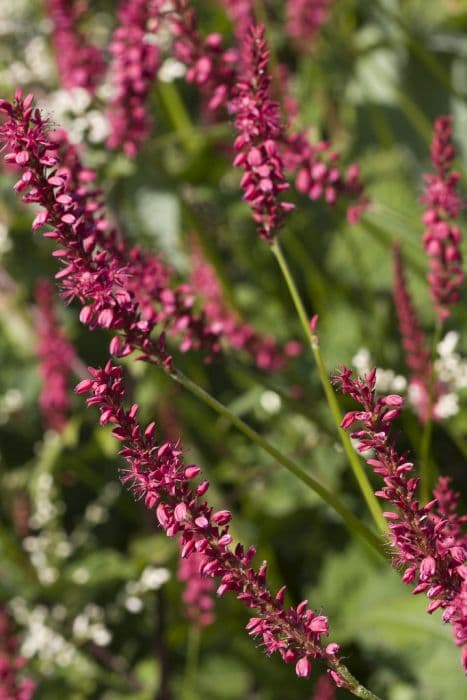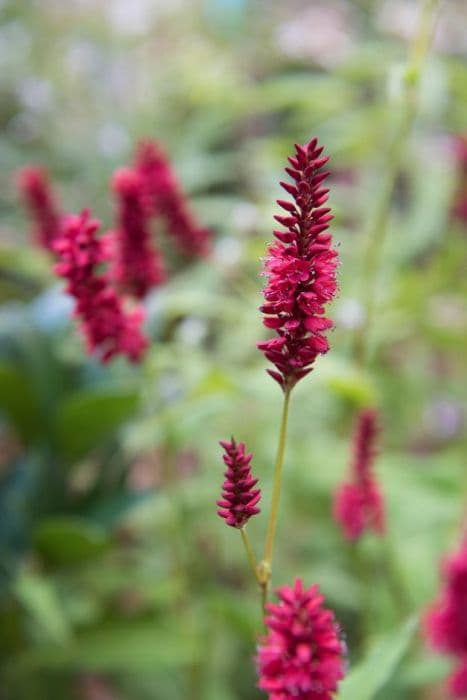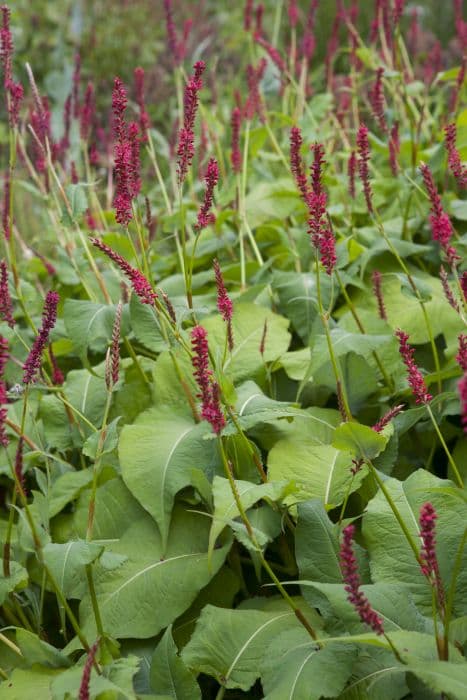Purple Fantasy Knotweed Persicaria runcinata 'Purple Fantasy'

ABOUT
Persicaria runcinata 'Purple Fantasy,' also known as Painter's Palette, is a distinctive and colorful plant. Its standout feature is its foliage, which boasts a unique combination of colors and patterns. The leaves are arrowhead-shaped with a rich, deep purple hue as the main background color. Irregular splashes and swirls of silver and green decorate each leaf, creating a marbled or painted effect that is quite eye-catching. The foliage often exhibits a glossy finish, which enhances the vibrancy of the colors and makes them seem even more luminous, especially when they catch the light. This variegation and the metallic sheen of the leaves are whimsical and give the plant a very ornamental look, adding aesthetic appeal to any garden setting. In contrast to the bold leaves, the plant produces small, subtle flowers. These flowers are typically an inconspicuous greenish-white or pinkish hue and may appear on slender spikes. However, they are often overlooked as the foliage tends to be the main attraction of this striking plant.
About this plant
 Names
NamesFamily
Polygonaceae
Synonyms
Purple Fantasy Knotweed, Purple Fantasy Fleece Flower
Common names
Persicaria runcinata 'Purple Fantasy'.
 Toxicity
ToxicityTo humans
As of my last update, there is limited information available regarding the toxicity of 'Purple Fantasy' to humans. Therefore, it is not concretely known if this plant is poisonous or what symptoms might occur if ingested. However, as a general caution, it is advisable to avoid eating ornamental plants due to potential toxicity and the 'Purple Fantasy' should be treated with the same level of care until more information is available.
To pets
There is limited information available regarding the toxicity of 'Purple Fantasy' to pets. Specific toxic effects and symptoms of poisoning in pets, such as dogs or cats, resulting from ingestion of this plant are not well-documented as of my last update. As with all ornamental plants, it is prudent to prevent pets from ingesting 'Purple Fantasy' due to the potential for unknown toxic effects.
 Characteristics
CharacteristicsLife cycle
Perennials
Foliage type
Deciduous
Color of leaves
Variegated
Flower color
White
Height
3-4 feet (0.91-1.22 meters)
Spread
3-4 feet (0.91-1.22 meters)
Plant type
Herb
Hardiness zones
5-9
Native area
Himalayas
Benefits
 General Benefits
General Benefits- Aesthetic Appeal: Adds a splash of color to gardens with its purple-patterned leaves and attractive foliage.
- Low Maintenance: Requires minimal care once established, making it ideal for both novice and experienced gardeners.
- Drought Tolerance: Can withstand periods of low water, reducing the need for frequent irrigation.
- Rapid Growth: Grows quickly to create ground cover or fill in garden spaces efficiently.
- Soil Erosion Control: Helps prevent soil erosion when planted on slopes or in areas prone to water runoff.
- Companion Plant: Works well when planted alongside other garden plants, providing contrast and enhancing overall garden design.
- Wildlife Attraction: Attracts beneficial insects, which can help with pollination and natural pest control in the garden.
- Seasonal Interest: Offers visual interest throughout the growing season with its changing leaf patterns and colors.
 Medical Properties
Medical PropertiesThis plant is not used for medical purposes.
 Air-purifying Qualities
Air-purifying QualitiesThis plant is not specifically known for air purifying qualities.
 Other Uses
Other Uses- Persicaria 'Purple Fantasy' can serve as a natural dye source, as its vibrant leaves may offer unique color hues for artisanal fabrics.
- The plant can be used in educational settings for botany students to study leaf pigmentation and color variation in plants.
- 'Purple Fantasy' can act as a muse for artists and designers, providing inspiration with its intricate leaf patterns and shades of purple.
- This cultivar can be utilized in photography as a striking background or subject due to its distinctive foliage.
- Persicaria 'Purple Fantasy' can be planted in maze and labyrinth gardens as a visually intriguing and distinctive border plant.
- The plant is ideal for creating themed gardens, such as Gothic or 'black gardens', due to its dark foliage.
- In culinary presentations, 'Purple Fantasy' leaves can be used as an alluring garnish to enhance the visual appeal of dishes.
- This persicaria variety can be used in crafting, such as in the creation of natural and biodegradable confetti or decorations.
- 'Purple Fantasy' can be integrated into performance art or fashion displays, where its dramatic appearance can complement costumes or staging.
- The plant is suitable for use in creating temporary natural art installations, as it can add stunning visual contrast against green landscapes.
Interesting Facts
 Feng Shui
Feng ShuiThe plant Purple Fantasy is not used in Feng Shui practice.
 Zodiac Sign Compitability
Zodiac Sign CompitabilityThe plant Purple Fantasy is not used in astrology practice.
 Plant Symbolism
Plant Symbolism- Transformation: The 'Purple Fantasy' variety of Persicaria runcinata, with its unique foliage that transitions from green to deep purple, represents change and the beauty of transformation.
- Versatility: Persicaria plants often thrive in a variety of conditions, symbolizing adaptability and resilience in various environments and situations.
- Growth: Like many plants, Persicaria runcinata 'Purple Fantasy' symbolizes growth, both physical and personal, as it proliferates throughout the growing season.
- Creativity: The striking patterns and colors of the 'Purple Fantasy' leaves suggest creativity and imagination, inspiring one to think outside the box.
 Water
WaterThe Mile-a-Minute vine, commonly known as Persicaria runcinata 'Purple Fantasy', requires consistent moisture, but it is important not to overwater to avoid waterlogging. Water the Mile-a-Minute thoroughly once the top inch of soil starts to dry out, which may be roughly once a week, depending on the climate and indoor conditions. Using a watering can, aim to apply water directly to the soil rather than over the foliage to reduce the risk of fungal diseases. A guideline to follow is approximately 16 ounces of water per square foot of soil every week, but always adjust according to your plant's response and the environmental conditions.
 Light
LightThe Mile-a-Minute prefers bright, indirect light for optimal growth. Place it in a spot where it can receive ample light without being exposed to the harsh afternoon sun, which can scorch the leaves. An east-facing or north-facing window is typically ideal, providing a balance of light throughout the day.
 Temperature
TemperatureMile-a-Minute thrives in temperate conditions, with an ideal temperature range of 60 to 75 degrees Fahrenheit. It can tolerate temperatures as low as 50 degrees Fahrenheit and as high as 80 degrees Fahrenheit. Always protect the Mile-a-Minute from drastic temperature fluctuations and cold drafts to prevent stress and damage.
 Pruning
PruningPruning the Mile-a-Minute helps maintain its shape and encourages a denser, bushier growth. It's best to prune in late winter or early spring before new growth begins. Trim back overgrown shoots and remove any dead or damaged leaves. Pruning can be done every few months or as needed to keep the plant looking its best. Always use clean, sharp pruning shears to make clean cuts.
 Cleaning
CleaningAs needed
 Soil
SoilPainter's Palette prefers a soil mix that is well-draining, rich in organic matter, and slightly acidic to neutral in pH (6.0-7.0). A mixture of potting soil, compost, and perlite or vermiculite can create an ideal environment for this plant to thrive. Such a blend ensures proper moisture retention while allowing excess water to drain, preventing root rot.
 Repotting
RepottingPainter's Palette should be repotted every 2-3 years or when it becomes root-bound. This is typically evident when roots start to grow through the drainage holes or the plant's growth seems stunted. Spring is the best time to repot to minimize stress on the plant and to give it a fresh start for the growing season.
 Humidity & Misting
Humidity & MistingPainter's Palette prefers moderate to high humidity levels but is adaptable to average indoor humidity. While it can tolerate humidity levels as low as 40%, it thrives best when the humidity is kept around 60% or higher. To increase humidity, you can use a humidifier or place the pot on a tray of wet pebbles.
 Suitable locations
Suitable locationsIndoor
Provide bright, indirect light and keep soil moist.
Outdoor
Plant in partial shade, keep soil moist, protect from frost.
Hardiness zone
4-8 USDA
 Life cycle
Life cyclePersicaria runcinata 'Purple Fantasy', commonly known as 'Purple Fantasy Knotweed', begins its life cycle as a seed, which when germinated in warm, moist soil, sprouts into a seedling. As the plant grows, it develops a robust root system and shoots that unfold into distinctive, variegated leaves with a purple and green pattern. This herbaceous perennial reaches maturity when it forms a clump with multiple stems and leaves, and in summer, it produces spikes of inconspicuous white or pinkish flowers that are attractive to pollinators. After pollination, the flowers give way to small fruits that contain seeds, completing the reproductive cycle. During the autumn, 'Purple Fantasy Knotweed' dies back to the ground, with the roots lying dormant through the winter. In spring, the plant regrows from the rootstock, repeating its life cycle.
 Propogation
PropogationPropogation time
Spring-Summer
Propogation: Persicaria runcinata 'Purple Fantasy', commonly known as knotweed, can be propagated during the spring or early summer when the plant is actively growing. The most popular method of propagation for this plant is by division. This entails digging up the entire plant and gently separating it into smaller sections, each with a piece of the root system. When dividing, make sure that each new section has at least one growing point or shoot to ensure successful growth. Once divided, the sections can be immediately replanted in well-draining soil, ensuring that the transplants are watered thoroughly to help establish the new roots. It's important to space the divisions to allow adequate room for future growth. Knotweed divisions typically take hold quickly and begin to grow, spreading to fill in the space provided.









